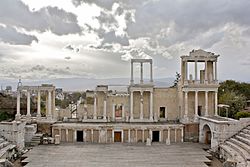| Old town in Plovdiv | |
|---|---|
 | |
| Location | Plovdiv, Bulgaria |
| Coordinates | 42°08′59″N24°45′10″E / 42.149824°N 24.752665°E |
| Area | 35 ha |
| Built | Thracian settlement: 4000 BC Hellenic settlement: 342 BC Roman settlement:46 AD Revival houses: 1800-1900 |
The old town in Plovdiv is an architectural and historical reserve located on three of Plovdiv's hills: Nebet Tepe, Dzhambaz Tepe and Taksim Tepe.
Contents
- Ancient monuments
- Nebet Tepe
- Ancient theatre
- Hisar Kapia
- Eastern gate of Philippopolis
- Revival architecture
- Balabanov House
- Danov House
- Kuyumdzhioglu House
- Hindliyan House
- Lamartine/Mavridi House
- References
The complex has been formed as a result of the long sequence of habitation from prehistoric times to present day and combines the culture and architecture from Antiquity, Middle Ages and Bulgarian revival. The old town in Plovdiv is included in UNESCO World Heritage tentative list since 2004. [1]












